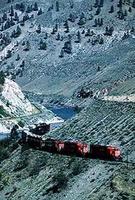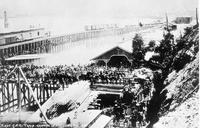Canadian Pacific Railway
CANADIAN PACIFIC RAILWAY (CPR) began construction in BC on 15 May 1880 at YALE.
The Construction Period
A rail link to eastern Canada had been a condition of BC's entry into CONFEDERATION in 1871 and the CPR was a fulfilment of that promise. Prime Minister John A. Macdonald had initially said that ESQUIMALT on VANCOUVER ISLAND would be the western terminus of the line. When the impracticality of that decision became clear, the terminus was changed to PORT MOODY. In 1879 Andrew ONDERDONK, an engineer representing an American syndicate, won the contract from the federal government to build the Fraser Canyon section of the line, the first section to be built in BC. Onderdonk needed a huge labour force, which he acquired first from California and then from China. CHINESE workers were favoured because they accepted lower pay and worked diligently at even the most dangerous tasks. Several thousand Chinese worked on CPR construction (6,500 were employed in 1883) and an estimated 600 of them died. Along with the canyon section, Onderdonk received the contract to build west to the coast and east to EAGLE PASS. Rail construction from the east reached KICKING HORSE PASS on the Alberta border in 1883. On the west side of the pass the line descended the "Big Hill" to FIELD on a 4.5% temporary grade. Extra locomotives were required to get trains up the hill and very strict precautions were necessary to prevent runaways on the downhill slope. Finally the CPR built the Spiral Tunnels between 1907 and 1909 to eliminate the Big Hill, reducing the grade to 2.2% by looping tracks through long tunnels bored through the mountains. Meanwhile construction continued over ROGERS PASS during 1885 and in November met Onderdonk's crew from the west at CRAIGELLACHIE, just west of REVELSTOKE; there, on 7 Nov 1885, the last spike was driven.
The CPR in Vancouver
The first scheduled passenger train from Montreal arrived at Port Moody on 4 July 1886. It took 5 days, 19 hours to complete the trip. A spur line to NEW WESTMINSTER opened later that year. Port Moody's celebration was short-lived, however. The CPR decided to relocate its terminus farther down BURRARD INLET at GRANVILLE, which quickly incorporated as VANCOUVER, and where the province granted the railway 24.3 sq km of land. The first train arrived there on 23 Feb 1887, though the formal first arrival was celebrated on 23 May. The presence of the railway virtually guaranteed that Vancouver would develop into the commercial and transportation capital of the province. It also secured the futures of the several southern Interior communities through which it passed. In return for building the railway the CPR received 45,000 sq km of public land in BC, consisting of a 32-km-wide belt straddling the main line. Later the company also received many more large parcels of land along its southern route.
A Southern Route
In the KOOTENAY, the discovery of SILVER at NELSON in 1887 sparked a MINING rush. At first, transportation to and from the area was by steamboat (see PADDLEWHEEL STEAMBOATS) on KOOTENAY LK and KOOTENAY R connecting south to the US. The CPR tried to divert traffic north by opening a small line, the COLUMBIA & WESTERN RWY, between Nelson and ROBSON in 1891. Combined with steamers on the ARROW LKS, this line, the first in southeast BC, connected the mining area to the CPR main line at Revelstoke. But growing competition from J.J. Hill's GREAT NORTHERN RWY to the south convinced the CPR that it had to build a line across the south of the province. In 1897 it negotiated the Crow's Nest Pass Agreement with the federal government. In return for a subsidy of $3.3 million, the CPR promised to maintain reduced freight rates on key commodities in the west (the infamous Crow Rate) and to build a rail line from Fort Macleod, AB, across the CROWSNEST PASS to the south end of Kootenay Lk. The 400-km line was completed in 1898, leaving a gap between the bottom of the lake and Nelson that was filled by sternwheelers, tugs and barges until track was laid up the west side of the lake between 1929 and 1931. The CPR also extended its C&K Rwy from Robson south to TRAIL and ROSSLAND in 1898 by purchasing the Columbia & Western Rwy and SMELTER operations of F. Augustus HEINZE. These later formed the basis of the CPR-owned mining giant, COMINCO. The Columbia & Western was extended west as far as MIDWAY by 1900. The CPR finally completed its line across southern BC in 1916, when it opened the KETTLE VALLEY RWY from Midway to the main line at HOPE.
Steamships and Hotels
On the coast, the CPR branched into steamship service in 1901 with the purchase of the CANADIAN PACIFIC NAVIGATION CO and the subsequent introduction of its PRINCESS LINE. On Vancouver Island, it purchased the ESQUIMALT & NANAIMO RWY from the DUNSMUIR family. The CPR also built the Vancouver Hotel (1887) and Victoria's EMPRESS HOTEL (1908) to anchor its chain of railway hotels, which included Mount Stephen House at Field (1886), Fraser Canyon House at NORTH BEND (1887), GLACIER HOUSE (1887), Revelstoke Hotel (1896) and Hotel Sicamous (1898). The railway was the largest landholder in Vancouver, owning about 50% of the real estate, and was a significant force in the development of the city for many years to come.
Until the 1950s CPR trains were powered by steam locomotives. Following WWII the railway began converting to diesel-electric power, which was less expensive to operate. The first section to become diesel powered was the Esquimalt & Nanaimo, which converted in 1949. By the mid-1950s, diesel locomotives were in use everywhere in BC on the CPR. At the same time, passenger service continued its inexorable decline. Early in 1964 CPR passenger service was discontinued along the southern route to the Crowsnest Pass. Then, in 1977, passenger service for both the CPR and the CANADIAN NATIONAL RWY was combined in a new CROWN CORP, VIA Rail Canada. VIA took over operation of the Canadian, the CPR's remaining transcontinental train, and the E&N passenger service on Vancouver Island. In 2001 Canadian Pacific Ltd. broke apart into five separate companies, one of which, Canadian Pacific Railway Co., continued to operate freight service across southern BC. Major commodities carried include grain, COAL, sulphur and potash. Much freight was carried by intermodal trains moving trailers and containers. Another of the companies, Canadian Pacific Hotels, operated the second largest hotel chain in the world, including the Empress in Victoria and the Vancouver Hotel. In 2006 the hotel chain was purchased by Saudi Prince Alwaleed bin Talal bin Abdulaziz Alsaud, reputed to be the 5th richest person in the world. A third company is FORDING INC.
Reading: Robert D. Turner, West of the Great Divide: An Illustrated History of the Canadian Pacific Railway in BC, 1880–1986, 1987.


